Gregory A. Fournier's Blog, page 35
October 24, 2014
Title IX Bares its Teeth in the Fight Against Campus Rape
 In a recent San Diego public radio news story entitled Fraternity Culture Linked to College Sexual Assault Problem, I was surprised to discover that college fraternities indemnify themselves against sexual assault charges. That's correct! Rape is built into the cost structure of their insurance policies. Sexual assault charges against fraternity members represent the second largest percentage of claims brought against fraternities except for assault and battery charges. When parents send their daughters to universities, they don't sign them up for that.
In a recent San Diego public radio news story entitled Fraternity Culture Linked to College Sexual Assault Problem, I was surprised to discover that college fraternities indemnify themselves against sexual assault charges. That's correct! Rape is built into the cost structure of their insurance policies. Sexual assault charges against fraternity members represent the second largest percentage of claims brought against fraternities except for assault and battery charges. When parents send their daughters to universities, they don't sign them up for that.Time magazine took a hard look at the issue of sexual assault on America's college campuses in its May 26th, 2014 cover story "Rape: Crisis in Higher Education," by Eliza Gray. The Department of Education released a list of fifty-five colleges that are under federal scrutiny over how they handle sexual assault complaints. When United States Assistant Attorney General for Civil Rights Thomas Perez stood before a press conference and announced there would be a federal investigation of the University of Montana, he told the reporters that "In the last three years, there have been at least eighty reported rapes connected with the university." Perez announced that the university, the city police, and the county attorney were all under investigation. "Other big public institutions like Ohio State, Harvard, and Princeton are also under investigation," he added.
Eliza Gray concluded that the problem is much broader than the big name universities who get all the bad publicity. "The truth is, for young women, particularly those who are eighteen and nineteen years old and just beginning their college experience, America's campuses are hazardous places. Recent research shows that one in five women is the victim of an attempted or completed sexual assault during college." Statistics also revealed the obvious that three-quarters of rape victims were incapacitated by alcohol. "College party culture takes particular advantage of young women who lack experience with alcohol," reported Gray.

Because of the cultural tolerance for drunken fraternity parties, aptly portrayed in the 1978 movie Animal House, it is a rite of passage for many young men and women to drift into the "Greek" party environment to see what it is all about. Campus life is a liberating cocktail of new found freedoms for freshmen. But large scale frat parties offer protective cover for sexual assault and attracts more than its share of predatory males looking to have sex with inexperienced and incapacitated young women. This testosterone-driven environment is fueled with large amounts of alcohol and date rape drugs that many young college women fall prey to.
The latest study shows that only12% of university rapes are ever reported to law enforcement because of fear of retaliation. The study also found that women in sororities are 74% more likely to experience rape than other college women. The number of universities the U.S. Department of Education is investigating has grown to eighty. Their study seeks to assess how universities respond to rape on their campuses and has been focused primarily on athletic departments and fraternity row. But the federal government is also examining how university officials and law enforcement handle these charges when they are brought to their attention.
Title IX is a 1977 law that combats gender discrimination in college sports. The Obama Administration has turned it into a weapon in the fight against rape on America's college campuses. In April of 2011, the Department of Education sent a letter warning colleges and universities to adequately address the issue of sexual assault on their campuses or risk losing federal funding.
Fraternity Culture Linked to College Sexual Assault Problem KPBS, October 21, 2014
http://www.kpbs.org/news/2014/oct/21/fraternities-and-campus-sexual-assault-problem/?utm_source=facebook.com&utm_medium=referral&utm_campaign=user-share&utm_content=facebook-button&utm_term=share-button
Rape Culture Reality Check: http://inthesetimes.com/article/16776/rape_culture_reality_check
Published on October 24, 2014 07:08
October 15, 2014
Ukraine Ranks Second Largest Fornology Audience
 Ukrainian folk costume with lovely traditional hand embroidery.Since I began my blog in May of 2011, the United States has been my biggest audience of Fornology readers by far. But from the start, the second place spot has been shared alternately by Great Britain, Canada, and Germany, with Australia occasionally making a run for the second place spot. But in 2013, I added a translator feature to Fornology's sidebar and noticed a change in my international audience ratings.
Ukrainian folk costume with lovely traditional hand embroidery.Since I began my blog in May of 2011, the United States has been my biggest audience of Fornology readers by far. But from the start, the second place spot has been shared alternately by Great Britain, Canada, and Germany, with Australia occasionally making a run for the second place spot. But in 2013, I added a translator feature to Fornology's sidebar and noticed a change in my international audience ratings. Russia had always made my top ten list but now they were climbing up the ranks. France and China started to hit my blog list at roughly the same time, but second place seemed to belong to Russia and Germany for many months on my All-time category report. Then Turkey began to rise up the ranks of my top ten and showed an interest in what I was writing. Finally, in late 2013 and into early 2014, Ukraine started making it onto the listing.
This new audience began to bound up my top ten list. Finally it happened. Ukraine leaped into second place in every reported category for the last month (Now, Day, Week, Month, and All-time). No other country had come on as strong and as fast as Ukraine. It struck me that I needed to find out more about these proud people who have suffered much at the hands of history.
Pageviews by Countries
 EntryPageviewsUnited States79921Ukraine3099Germany2896Russia2869France2080Canada1958United Kingdom1724Turkey1224China915Spain705
EntryPageviewsUnited States79921Ukraine3099Germany2896Russia2869France2080Canada1958United Kingdom1724Turkey1224China915Spain705 (All-time list as of October 13th, 2014)
Like most Americans, I am woefully ignorant about Ukraine, other than it has been having sovereignty problems with the Russians over Crimea, and they have been moving towards possible civil war. Unlike many Americans, I can find Ukraine on the map. It is in southeastern Europe bordering the Black Sea between Poland, Romania, and Moldova to the west and the Great Russian Bear to the east. Its capital city is Kiev (Kyiv), one of the oldest and largest cities in Europe. Ukraine is 603,550 square kilometers with a population of 45,000,000 people.
In high school, all we learned in history class about "the Ukraine" was that it was the "Breadbasket of the Soviet Union," and its people were brutalized by the Soviets and the Nazis during World War II. Why Ukrainians have shown such a strong interest in my Fornology blog is a mystery to me, so I decided to learn more about them, their history, and their culture and pass that information on to my Fornology readers.
 The Ukrainian National FlagIn recent history, Ukraine became independent from the Union of Soviet Socialist Republics (USSR) when that communist regime dissolved in 1991. It is on August 24th that Ukrainians celebrate their Independence Day. The national flag of Ukraine was adopted in 1992. It simply consists of two stripes arranged horizontally, one blue stripe on top representing the skies and rivers of Ukraine and a yellow stripe below symbolizing Ukraine's lush golden wheat fields. Ukraine has a fledgling constitutional republic struggling to maintain its country's independence from Russia and its president, Vladimir Putin.
The Ukrainian National FlagIn recent history, Ukraine became independent from the Union of Soviet Socialist Republics (USSR) when that communist regime dissolved in 1991. It is on August 24th that Ukrainians celebrate their Independence Day. The national flag of Ukraine was adopted in 1992. It simply consists of two stripes arranged horizontally, one blue stripe on top representing the skies and rivers of Ukraine and a yellow stripe below symbolizing Ukraine's lush golden wheat fields. Ukraine has a fledgling constitutional republic struggling to maintain its country's independence from Russia and its president, Vladimir Putin. Bohdan Khmelnytsky, "Hetman of Ukraine", established an independent Ukraine after the uprising in 1648 against Poland.
Bohdan Khmelnytsky, "Hetman of Ukraine", established an independent Ukraine after the uprising in 1648 against Poland.Ukraine has an ancient history and its territory has changed and moved around many times since it was founded in 882 AD as Kievan Rus'. In 1240 AD there was a Mongol conquest, but by the 14th Century, the region was ruled by the Golden Horde, the Grand Duchy of Lithuania, and Poland before becoming a Cossack state in 1648. For most of the 18th and 19th Centuries, most of Ukraine was part of the Russian Empire, and the rest was controlled by the Austria-Hungary Empire.
Ukraine was free for a brief period after the Russian Revolution between 1917-1920. Ukraine became a republic of the Soviet Union from 1922 until 1991 when that communist regime collapsed. Check the link below for more detailed information from CNN on Ukraine's ongoing political crisis.
 Traditional Ukrainian cuisineUkrainian food is typically Eastern European. Hard cheeses, sausage, and borshch (beet soup), the national soup of Ukraine, are traditional dishes. Holubtsi (stuffed cabbage rolls), kovbasa (smoked or boiled sausage), and varenyky (dumplings with various meat, fruit, or vegetable fillings) are also part of traditional Ukrainian cuisine. Baked goods are bublik (similar to a bagel but bigger), babka (Easter bread made with sweet dough and dried fruit baked in a tall, cylindrical shape), and paska (traditional butter and egg rich Easter bread decorated with Easter symbols baked on top).
Traditional Ukrainian cuisineUkrainian food is typically Eastern European. Hard cheeses, sausage, and borshch (beet soup), the national soup of Ukraine, are traditional dishes. Holubtsi (stuffed cabbage rolls), kovbasa (smoked or boiled sausage), and varenyky (dumplings with various meat, fruit, or vegetable fillings) are also part of traditional Ukrainian cuisine. Baked goods are bublik (similar to a bagel but bigger), babka (Easter bread made with sweet dough and dried fruit baked in a tall, cylindrical shape), and paska (traditional butter and egg rich Easter bread decorated with Easter symbols baked on top).
A Ukrainian folk art is Pysanka, decorated Easter eggs which are well-known the world over. Each region has its own traditional designs. They use the wax relief method to write intricate designs with beeswax to create symbolic patterns, next the eggs are dyed colors that also carry symbolic significance. The eggs are strongly tied to the Easter holiday and are painted during Holy Week to symbolize the rebirth of man and Jesus Christ's resurrection.
Woven goods with colorful embroidered motifs from around the country are found in traditional folk costumes worn for holidays and special occasions. Men's shirts and women's blouses and decorative vests are embroidered in brilliant colors with regional patterns, each with its own symbolic meaning.
 Ukrainian customs and culture are heavily influenced by Christianity. Almost ninety percent of Ukraine's religious community is either Eastern Orthodox, Greek Orthodox, or Roman Catholic, though 40% of its general population claim to be atheists. This is a residual effect of the Russification of Ukraine's population during Soviet domination to discourage Ukrainian national identity. But without their religious traditions to bind them through the dark times, Ukraine would long ago have lost its national identity, its heart, and its very soul. Even now, Ukraine struggles.
Ukrainian customs and culture are heavily influenced by Christianity. Almost ninety percent of Ukraine's religious community is either Eastern Orthodox, Greek Orthodox, or Roman Catholic, though 40% of its general population claim to be atheists. This is a residual effect of the Russification of Ukraine's population during Soviet domination to discourage Ukrainian national identity. But without their religious traditions to bind them through the dark times, Ukraine would long ago have lost its national identity, its heart, and its very soul. Even now, Ukraine struggles. 
The Ukrainian people like celebrations with family and friends, but as a people, they tend to be fatalistic because of their history and geography. Their country has been the corridor to Europe in the west and to Asia in the east since before written history. Their history is written in blood and is reflected in the Ukrainian anthem, Shche ne vmerla Ukraina (Ukraine has not yet died!). May Ukraine live long and prosper!
For more background on Ukraine's current political crisis with Russia, consult this CNN link: http://www.cnn.com/2014/02/28/world/europe/ukraine-fast-facts/
Petrykivka - Ukrainian ornamental folk art documentary in the Ukraine language. If the audio distracts you, turn the sound down and enjoy the visuals: https://www.youtube.com/watch?v=PsvcffwMpWg
Published on October 15, 2014 06:32
October 9, 2014
Homage to Detroit
 I just returned from a successful two week trip to the Detroit area to speak about my novel Zug Island and wrap up some final interviews for my current writing project The Rainy Day Murders (RDM). Since I began work on RDM in June of 2011, I have flown into the Detroit area nine times to do archival and field research with the help of my friend and project manager Ryan M. Place. Every trip has been enlightening, informative, and productive regarding the Washtenaw County murders (1967-1969) and John Norman Collins' role in them. Now, that project is winding down.
I just returned from a successful two week trip to the Detroit area to speak about my novel Zug Island and wrap up some final interviews for my current writing project The Rainy Day Murders (RDM). Since I began work on RDM in June of 2011, I have flown into the Detroit area nine times to do archival and field research with the help of my friend and project manager Ryan M. Place. Every trip has been enlightening, informative, and productive regarding the Washtenaw County murders (1967-1969) and John Norman Collins' role in them. Now, that project is winding down. Unlike previous trips to the Motor City, this recent trip was a mixture of business and vacation. What characterized this trip for me was a personal feeling of accomplishment and a sense that Detroit may actually be on the comeback trail. While I was there, my wife and I got to share the excitement of the Tigers run for the playoffs and the disappointment of the Orioles sweep in three. As transplanted San Diego Padres fans, it was nice for us to have something to cheer about, even for a little while. Comerica Park is a real gem and a great place to see a ball game in the center of Downtown.
Unlike previous trips to the Motor City, this recent trip was a mixture of business and vacation. What characterized this trip for me was a personal feeling of accomplishment and a sense that Detroit may actually be on the comeback trail. While I was there, my wife and I got to share the excitement of the Tigers run for the playoffs and the disappointment of the Orioles sweep in three. As transplanted San Diego Padres fans, it was nice for us to have something to cheer about, even for a little while. Comerica Park is a real gem and a great place to see a ball game in the center of Downtown.Another notable hot spot in Downtown Detroit is Cafe D'Mongo's Speakeasy on Griswold St. I was able to meet and speak with Larry D'Mongo in his club one afternoon to discuss the past and his view of present day Detroit. We talked about the "67" riots and recent city history. Mr. D'Mongo is truly the Griot of Griswold Street. His night spot is full of Detroit memorabilia, old time family photos, and noteworthy art work. This vintage Detroit bar has a long and fascinating history contained within its walls.
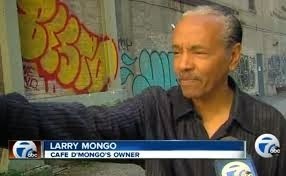
I went there last Saturday night and the place was standing room only, with a vibrant mix of the new face of Detroit, energetic, young, upwardly mobile, and optimistic. Cafe D'Mongo's Speakeasy is open only on Fridays from 5:00 PM until 1:30 AM and Saturday nights from 8:30 PM until closing. Next time I'm in town, I'll be back for some of that soul food and local Detroit flavor.
I usually travel to Detroit alone, but this trip was business and pleasure, so my wife was surprised to discover that my Allen Park High School Facebook friends were real and not my imaginary friends. Happily, I was able to meet with several of them one evening at the Wheat & Rye on Allen Rd.
 Allen Park High School - Class of 1966 members.
Allen Park High School - Class of 1966 members.Once upon a time in the 1960s, my parents owned that bar under the guise of The Cork & Bottle. A high school friend of mine owns it now and has improved the business. It is the home of Downriver's legendary giant pastrami sandwich which rivals the sandwiches at the famous Carnegie Deli in New York City.
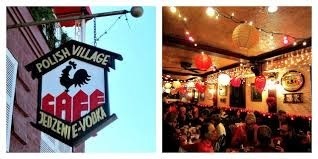 Though I don't normally post about food or restaurants, there has never been a shortage of great places to eat in and around Detroit. The Polish Village Cafe in Hamtramck is always a must stop for me when I'm in town, and the Polish Art Center gift shop on Joseph Campau Ave. is a must see. Hamtramck reminds me of growing up in Detroit back in the 1950s.
Though I don't normally post about food or restaurants, there has never been a shortage of great places to eat in and around Detroit. The Polish Village Cafe in Hamtramck is always a must stop for me when I'm in town, and the Polish Art Center gift shop on Joseph Campau Ave. is a must see. Hamtramck reminds me of growing up in Detroit back in the 1950s.The Rhapsody on Northline Road in Southgate specializes in authentic Hungarian food and was a great new find. This restaurant has a comfortable dining room and great service. Its walls are festooned with craft displays. As for the food? It was the best I had on my trip.
And when I'm in Ypsilanti doing serious research, I always like to have breakfast at The Bomber on Michigan Avenue, lunch at Aubrey's in Depot Town, and dinner at The Sidetrack across the street. I also indulged my passion for White Castle sliders a couple of times when I was on the run.
No trip to Michigan in the autumn is complete without a trip to an apple cider mill and ours was no different. We spent the day at Franklin Cider Mill with an Eastern Michigan University friend of mine who flew into Detroit from Albuquerque to hear my talk. As it so happened, she had her wedding reception at Pasquale's in Royal Oak many years ago. Small world!
 Author Claudia Whitsitt and me at Pasquale's.In closing, I want to personally thank the Book Club of Detroit and the Detroit Drunken History Society for sponsoring my Zug Island: A Detroit Riot Novel book talk at Pasquale's Italian Restaurant in Royal Oak, Michigan last week. One-hundred and nine people attended. An extensive buffet dinner was available and the food was fantastic. I look forward to returning here to discuss my true crime book RDM after it is published. My reception here was memorable and appreciated.
Author Claudia Whitsitt and me at Pasquale's.In closing, I want to personally thank the Book Club of Detroit and the Detroit Drunken History Society for sponsoring my Zug Island: A Detroit Riot Novel book talk at Pasquale's Italian Restaurant in Royal Oak, Michigan last week. One-hundred and nine people attended. An extensive buffet dinner was available and the food was fantastic. I look forward to returning here to discuss my true crime book RDM after it is published. My reception here was memorable and appreciated.Thomas Wolfe once wrote "You Can't Go Home Again." Well, I did, and how sweet it was! Thanks, Detroit!
For more about Claudia Whitsitt and her books, visit her website at
http://www.claudiawhitsitt.com/
To find out more about my novel Zug Island, check out
http://www.amazon.com/Zug-Island-Detroit-Riot-Novel/dp/1604945850
Published on October 09, 2014 05:29
September 28, 2014
Detroit's Liquid Gold - Vernor's Ginger Ale
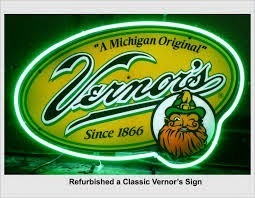
One of Detroit's most beloved hometown products was Vernor's Ginger Ale, reputed to be the world's first soft-drink. The folklore about the formula was part of the product's trademark advertising, "Aged four years in wood." When the Vernor's family sold the business and trademark in 1966, the company motto underwent a subtle but telling change. It became "Aged for years in wood." Rather than the original four-year formulation, it was cut down to three years. Now, the Dr. Pepper & Snapple Group owns the Vernor's trademark and bottling rights.
The pure cane sugar of the original formula gave way to high fructose corn syrup and other sweeteners. Caramel, vanilla, and extract of ginger root are no longer listed as ingredients, just "artificial flavorings." So people who remember the original Vernor's loved the golden sweetness, the effervescent carbonation, and the ginger root extract taste of the original.
That said, Vernor's is still the tastiest ginger ale drink on the market today. It puts Canada Dry Pale Ginger Ale to shame. Vernor's is a soft-drink, and Canada Dry is a mixer for liquor. The two should never be confused.
 Vernor's is the oldest surviving ginger ale brand in the United States. Legend has it that just prior to the beginning of the Civil War, a drugstore clerk, James Vernor tried to duplicate the taste of a popular Irish ginger ale. He was called off to war, so he stored his syrup made from a formula of nineteen ingredients in an oak cask. When he returned from the war in 1865, he opened the keg and found his formula had mellowed from the aging process. Four years to be exact. James was said to have exclaimed, "It's deliciously different," which became the drink's trademark motto. He called his soda fountain creation a "soft drink" because it contained no alcohol or narcotic ingredients. It is said to be the first soft drink. Soon, the company added the motto, "Aged Four Years in Wood."
Vernor's is the oldest surviving ginger ale brand in the United States. Legend has it that just prior to the beginning of the Civil War, a drugstore clerk, James Vernor tried to duplicate the taste of a popular Irish ginger ale. He was called off to war, so he stored his syrup made from a formula of nineteen ingredients in an oak cask. When he returned from the war in 1865, he opened the keg and found his formula had mellowed from the aging process. Four years to be exact. James was said to have exclaimed, "It's deliciously different," which became the drink's trademark motto. He called his soda fountain creation a "soft drink" because it contained no alcohol or narcotic ingredients. It is said to be the first soft drink. Soon, the company added the motto, "Aged Four Years in Wood."James Vernor died in Grosse Ile, Michigan on October 29th, 1927 at the age of eighty-four from pneumonia and influenza. He handed his business down to his son James Vernor, Jr. When James was interviewed in 1936, he admitted that his father created the formula after the Civil War. Former company president James Vernor Davis and grandson of the originator confirmed the story in a 1962 interview. According to their trademark application, Vernor's ginger ale first entered commerce records in 1880 and not 1866 as the company's marketing still states.
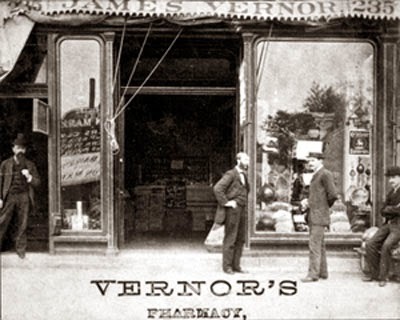 1870s
1870sOriginally, Vernor's ginger ale was sold only as a soda fountain drink in his own pharmacy on 235 Woodward Ave on the corner of Clifford St. In 1896, James Vernor sold the drugstore and went full-time into the soda franchising business throughout the Midwest states.
When James Sr. died, his son James Jr. took over the business and expanded it into a 230,000 sq, ft. bottling plant and headquarters on Woodward Ave., one block from the Detroit River. Vernor's was ready for mass production and the home consumption market. His father had limited the franchises to selling the Vernor's syrup to drugstore soda fountains. Now the business took off and became a regional sensation.

Vernor's agreed to move their headquarters and bottling plant in the late 1950s. The city of Detroit needed the land for Cobo Hall and other riverfront projects. There was a property swap. The city traded the Vernor family, the old civic exhibition hall at 4501 Woodward Ave for there prime real estate. That is the Vernor's location the Baby Boomer generation knows best.
The term Detroiters use for soft drinks is "pop." It is said to have originated from the sound that the new capped, highly carbonated Vernor's bottles made when opened. The newer canned product makes more of a swish sound when the tab is pulled.
The Vernor family sold their business in 1966 to United Brands, Inc. They operated for another nineteen years, but they shut down the Detroit bottling plant in 1985 and sold out to Pepsi. Pepsi was itself soon bought by the British company Cadbury/Schweppes. Today, the Vernor's brand name and bottling rights belong to Dr. Pepper & Snapple Group.
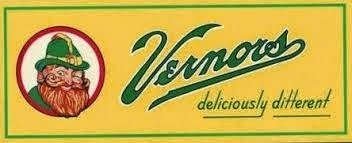
The familiar Vernor's gnome mascot trademark, Woody, was a creation of graphic artist Noble Fellows. It has been used since the beginning of the twentieth century but dropped in 1987. Woody fans will be happy to know that he was returned to packaging in the 2000s.
So much of Detroit's not so distant history has vanished. Just last week, the Bob-Lo Boat Columbia was unceremoniously towed from its moorings in Ecorse, never to ply the Detroit River again.
But a small part of Vernor's history was recovered recently when a building being torn down on Joy and Inkster roads in Westland, Michigan revealed a 1950s era billboard sign found intact, painted on the side of the building next to the demolished building. This image really reminds me of growing up in the Detroit area.
 Joy and Inkster roads in Westland, Michigan
Joy and Inkster roads in Westland, MichiganMany Detroiters wonder if the eye-popping Vernor's neon sign still exists and if it will ever be on display anywhere. It lit up Woodward Ave at night and is a piece of Detroit's history. Let's bring the gnome home!

Published on September 28, 2014 05:00
September 21, 2014
Delray Backdoor Shut -The West Jefferson Avenue Bridge Still Out of Commission
 Rouge River Bridge on West Jefferson BoulevardAfter ninety-one years of accident free operation, the Rouge River Bridge, aka the West Jefferson Avenue Bridge, sustained serious damage to its northeast side. Shortly after 2:00 AM on May 12, 2013, an intoxicated bridge operator prematurely lowered the bridge onto the Great Lakes Class freighter, the Herbert C. Jackson. It instantly collided with the north section of the double-leaf bascule bridge. The bridge's hydraulic gearing and its electrical equipment were unharmed in the accident.
Rouge River Bridge on West Jefferson BoulevardAfter ninety-one years of accident free operation, the Rouge River Bridge, aka the West Jefferson Avenue Bridge, sustained serious damage to its northeast side. Shortly after 2:00 AM on May 12, 2013, an intoxicated bridge operator prematurely lowered the bridge onto the Great Lakes Class freighter, the Herbert C. Jackson. It instantly collided with the north section of the double-leaf bascule bridge. The bridge's hydraulic gearing and its electrical equipment were unharmed in the accident.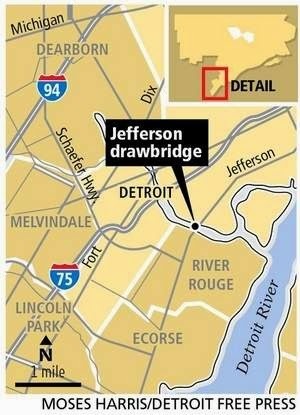 The bridge was closed immediately to vehicular and pedestrian traffic, both ends of the double-leaf bridge were left fully open to accommodate unhampered freighter use of the Rouge River. With this bridge in its down position, Great Lakes Class freighter access to the Ford Rouge Plant would cease.
The bridge was closed immediately to vehicular and pedestrian traffic, both ends of the double-leaf bridge were left fully open to accommodate unhampered freighter use of the Rouge River. With this bridge in its down position, Great Lakes Class freighter access to the Ford Rouge Plant would cease. ***
The single-leaf bascule bridge has a long history. It originated in Medieval Europe to help defend castles and walled towns by using winches and counterweights. Commonly known as drawbridges in English speaking countries, this style of bridge was used for crossing a moat or narrow river leading to the castle gate. Drawn upward with winches and counterweights when under attack, these single-leaf bascule bridges prevented easy access by invaders.
 Tower Bridge in LondonProbably the most famous double-leaf bascule bridge in the modern world is the Tower Bridge in London. Construction began in 1886 and the bridge opened in 1894. Many people mistake it for London Bridge. The Tower Bridge is a combination of suspension bridge and drawbridge on the Thames River.
Tower Bridge in LondonProbably the most famous double-leaf bascule bridge in the modern world is the Tower Bridge in London. Construction began in 1886 and the bridge opened in 1894. Many people mistake it for London Bridge. The Tower Bridge is a combination of suspension bridge and drawbridge on the Thames River. ***
The Rouge River Bridge was completed in 1922 after some jurisdictional legal wrangling and some new law writing. The previous narrow swing bridge had needed replacing since the 1910s, and the federal government had plans to dredge the Rouge River to accommodate direct freighter access to Henry Ford's new, massive Rouge Plant Complex. The inadequate Rouge River Bridge and the Fort Street Bridge would both be replaced with double-leaf drawbridges at the cost of one million dollars apiece. Wayne County voters approved a bond issue to fund construction.
To reroute traffic across the Rouge River while the new bridges were being built, an out-of-service railroad truss bridge owned by Michigan Central Railroad was detached from its moorings. A flotilla of scows pumped full of water to lower them in the river were towed under the truss bridge. When the water was pumped out of the scows, they rose and floated the bridge with the help of tugboats to a location 200 yards upstream of W. Jefferson Ave. The Fort Street Bridge and the W. Jefferson Avenue Bridge were closed on November 13, 1920, after the makeshift railroad truss detour was in place.
 Rouge River Bridge fully open in winter.
Rouge River Bridge fully open in winter.Each leaf of the dual-leaf bridges is supported by four 12 foot square concrete footings sunk in the clay to the bedrock 70 feet below the waterline. One worker died of "the bends" during construction because he decompressed too quickly after working in a caisson.
The bascule double-leaves of the Rouge River Bridge were lowered for the first time on August 21, 1922. It opened for traffic on October 17th of the same year. Finally, the bridge reconnected the Detroit neighborhood of Delray with the city limits of River Rouge and the rest of the Downriver area. In 1923, the federal government completed dredging the Rouge River and Great Lakes freighters were now able to navigate upstream, unload their cargo, and turn around in a massive turning basin built by the United States government expressly for that purpose.
In our present time, it is estimated that twenty to twenty-five freighters navigate this narrow waterway weekly. The bridge handled 6,400 vehicles daily in 2012, according to Southwest Michigan Council of Governments data.
Once again, after its ninety-one year record of service, the Rouge River Bridge is closed. The collision with the Herbert C. Jackson on May 12, 2013 was the first accident of its kind in the bridge's history. None of the crew on board the freighter were injured. The 670 foot-long ship sustained a 2 inch gash in its hull about 15 feet above the waterline. The freighter's cargo was 23,000 tons of iron ore pellets destined for the Severstal North American plant in Dearborn.
 Bridge's Control StationCindy Dingell, spokesperson for the Wayne County Operations Office, told reporters that the bridge operator was immediately tested for drugs and alcohol and was fired from her job, but no charges have been filed in connection with the incident.
Bridge's Control StationCindy Dingell, spokesperson for the Wayne County Operations Office, told reporters that the bridge operator was immediately tested for drugs and alcohol and was fired from her job, but no charges have been filed in connection with the incident.Dingell said that Wayne County doesn't have the resources to rebuild the bridge and may have to ask voters for a bond issue to fix it to the tune of $850,000 to $1,250,000. The Rouge River Bridge is the only surviving pony truss bascule bridge in the state of Michigan. It was listed in the National Register of Historic Places on February 10, 2000.
For more information on how a Chicago Type, double-leaf bascule bridge operates, tap on this link: https://multco.us/bridges/chicago-type-bascule-bridge
For information on my upcoming Zug Island: A Detroit Riot Novel book talk September 30, 2014: http://fornology.blogspot.com/2014/08/zug-island-book-talk-at-pasquales-in.html
Published on September 21, 2014 04:18
September 14, 2014
Allen Park's Uniroyal Giant Tire Heralds Entrance into The Motor City

The original U.S. Royal Tire exhibit was a Ferris wheel attraction at the New York World's Fair of 1964/1965, held in Flushing Meadows Corona Park in the borough of Queens. The fair was open for two six-month seasons. In 1964, it was open from April 22th until October 18th, and in 1965, the dates were April 21st until October 17th.
The history of the U.S. Royal Giant Tire is pretty straightforward. Originally rigged as a Ferris Wheel and powered by a 100 HP engine, it was over eighty feet high. It carried over 2,000,000 people at the World's Fair, many of them famous world figures. There were twenty-four barrel shaped gondolas, each carrying up to four people for a total of ninety-six passengers paying a quarter apiece.
 At the Fair's end, the tire was disassembled and shipped by rail to Detroit and reassembled as a static display outside the Uniroyal sales offices in Allen Park, Michigan. It is the world's largest roadside attraction. The Uniroyal office has since moved, but the Giant Tire still stands.
At the Fair's end, the tire was disassembled and shipped by rail to Detroit and reassembled as a static display outside the Uniroyal sales offices in Allen Park, Michigan. It is the world's largest roadside attraction. The Uniroyal office has since moved, but the Giant Tire still stands.The tire is not made of rubber, but sightseers don't notice the difference whizzing past the landmark at seventy miles an hour on Interstate 94. The tire weighs just under twelve tons and is anchored in twenty-four feet of concrete and structural steel. It is rated to withstand hurricane force winds.
 When the Michelin Tire Company bought out Uniroyal and Goodrich in 1990, they renovated the landmark in 1994 with a fresh coat of paint, a modern looking hubcap, and neon lights for the Uniroyal lettering. Four years later in 1998, the Giant Tire was modified again to resemble a "Nail Guard" tire. An eleven foot long, 250 pound nail (world's largest) was sticking out from the tire to promote their new puncture proof product. The nail was put up for auction on eBay in 2003 and sold for $3,000, with proceeds donated to the Allen Park Historical Museum.
When the Michelin Tire Company bought out Uniroyal and Goodrich in 1990, they renovated the landmark in 1994 with a fresh coat of paint, a modern looking hubcap, and neon lights for the Uniroyal lettering. Four years later in 1998, the Giant Tire was modified again to resemble a "Nail Guard" tire. An eleven foot long, 250 pound nail (world's largest) was sticking out from the tire to promote their new puncture proof product. The nail was put up for auction on eBay in 2003 and sold for $3,000, with proceeds donated to the Allen Park Historical Museum.In 2003, the Giant Tire was once again renovated as part of the I-94 corridor revitalization. The neon lettering was replaced with reflective lettering and spotlighting. It has remained a Detroit landmark and an Allen Park roadside attraction for forty-eight years heralding the entrance into the Motor City from Detroit Metropolitan Airport in Romulus, Michigan.
It has been noted that the one thing the Beatles wanted to see on their American tour was the Giant Tire. Whether they stopped along the freeway to take a good look at it on their way into Detroit from Metro Airport isn't known, but when Paul McCartney and Wings were touring in 1976, the moment was commemorated.
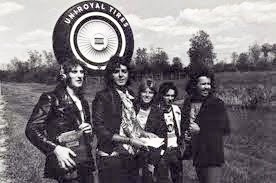
http://www.freep.com/article/20120312/COL14/203120336/Mark-Phelan-You-ve-seen-the-Giant-Tire-now-see-inside-of-it
Published on September 14, 2014 06:21
September 7, 2014
Bob-Lo Island - Another Fondly Remembered Detroit Tradition
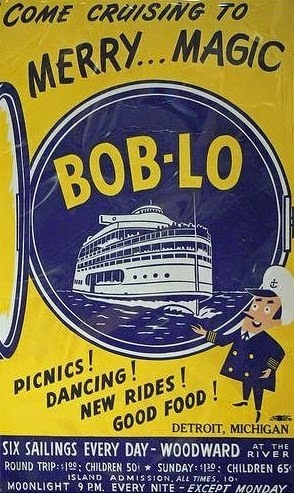 Bob-Lo Island was a family amusement park fondly remembered by Detroiters of a certain age. The park was located at the mouth of the Detroit River on Bois Blanc Island in Canadian waters off Amherstburg, Ontario. The name Bob-Lo is an American corruption of the French name for the island meaning White Woods. The Bob-Lo Island Amusement Park operated from 1902-1991.
Bob-Lo Island was a family amusement park fondly remembered by Detroiters of a certain age. The park was located at the mouth of the Detroit River on Bois Blanc Island in Canadian waters off Amherstburg, Ontario. The name Bob-Lo is an American corruption of the French name for the island meaning White Woods. The Bob-Lo Island Amusement Park operated from 1902-1991.The park's signature attractions were the Nightmare, the Falling Star, the Wild Mouse, the Sky Streak, and the Screamer. The park also had a Ferris wheel, a children's zoo, a train, and a carousel. The island had its own marina.

In 1913, Henry Ford was said to have financed the Dance Pavilion designed by John Scott. The 35,000 square feet of dance floor was the second largest in the world, holding 5,000 dancers at full capacity. For many years early on, this was the park's biggest money maker, charging five cents a dance per couple. Dance police were stationed on the dance floor. "The Turkey Trot, Bunny Hop, and Bear Dances were against the rules. Two Steps, Waltzes, and the Society Walk (Fox Trot) were allowed. Doing the Rag would get you kicked out," wrote Patrick Livingston, author of Summer Dreams: The Story of Bob-Lo Island (Wayne State University Press.)
The dance hall boasted the world's largest mechanical organ called an orchestrion, made in Germany. The contraption with 419 pipes and an automated percussion section was fourteen feet wide and sixteen feet high. It ran on electricity and worked like a player piano. The orchestrion is pictured on the second floor balcony on the right side of the vintage postcard above.
 Bob-Lo Boat Columbia - 1903What longtime Detroiters remember most fondly about Bob-Lo was the boat ride up and down the Detroit River. Ninety-seven year old Helen Robinson remembered going to Bob-Lo Island as a kid with a church group. A sudden squall came up from nowhere and the boat's crew had to lower the canvas flaps and lash them to the railings. Helen said that they all knelt down and prayed. The boat made it to the island, the sun broke through the clouds, and they enjoyed the rest of their day at the park. Adults remember the moonlight cruises to the island.
Bob-Lo Boat Columbia - 1903What longtime Detroiters remember most fondly about Bob-Lo was the boat ride up and down the Detroit River. Ninety-seven year old Helen Robinson remembered going to Bob-Lo Island as a kid with a church group. A sudden squall came up from nowhere and the boat's crew had to lower the canvas flaps and lash them to the railings. Helen said that they all knelt down and prayed. The boat made it to the island, the sun broke through the clouds, and they enjoyed the rest of their day at the park. Adults remember the moonlight cruises to the island.The Bob-Lo Excursion Company expanded an existing park and operated two excursion steamers out of Detroit and Wyandotte, Michigan. These Bob-Lo Boats were designed by Frank E. Kirby and built by the Toledo Ship Building Company. The Columbia was built in 1901 and went into service in 1902, while the Ste. Claire was built and went into service in 1910.
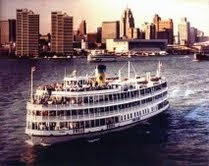 Excursion steamers were built primarily for day trips. They were propeller driven, powered by a triple expansion reciprocating steam engine. The boats were 190 feet (58m) long and 50 feet (15m) wide and were said to hold 2,500 passengers. The Columbia and the Ste. Claire are the last two steamers of their type still afloat. The Columbia ran the original Bob-Lo run for eighty-one years, a record of service on a single run unequaled in United States maritime history.
Excursion steamers were built primarily for day trips. They were propeller driven, powered by a triple expansion reciprocating steam engine. The boats were 190 feet (58m) long and 50 feet (15m) wide and were said to hold 2,500 passengers. The Columbia and the Ste. Claire are the last two steamers of their type still afloat. The Columbia ran the original Bob-Lo run for eighty-one years, a record of service on a single run unequaled in United States maritime history.In 1945, Bob-Lo Island Excursion Company made history rather than family memories. Sarah Elizabeth Ray took part in a company sponsored trip to Bob-Lo Island with twelve other female workers involved with the war effort. Ray was removed because she wasn't white. The State of Michigan filed a racial discrimination law suit against the company and won. The case was taken to the Michigan Supreme court and upheld.
The company policy excluded "so called 'zoot-suiters' and 'colored' because they were deemed rowdyish, rough, and boisterous." Their position was that they were operating a private concern in another country not subject to United States jurisdiction. The case was taken to the United States Supreme Court in 1948 where it upheld Michigan's anti-discrimination provisions on the grounds that the company's policy was a violation of United States Commerce Department regulations.

Another company tried to run the park after the Bob-Lo Island Excursion company sold out in 1991, but the park closed permanently on September 30, 1993 and sold off its rides in 1994. The Columbia and the Ste. Claire have been moth-balled at the U.S. Steel docks in Ecorse, Michigan since 1991. The Ste. Claire is being restored to the tune of about $15,000,000 with the goal of being completed by September of 2015, to resume active service as a sightseeing attraction trolling the Hudson River in New York City.
Related links:
Photographs of the Bob-Lo Island amusement rides. http://boblosteamers.com/amusement.html
YouTube video of Bob-Lo boats moored on Detroit River outside of U.S. Steel (the old Great Lakes Steel) docks on December 1, 2012. https://www.youtube.com/watch?v=-HUpQZ8P9Ro
Bob-Lo Island update, now becoming an upscale residential development. http://www.freep.com/article/20140706/NEWS05/307060053/boblo-island-memories-boat-development
The Bob-Lo Island Dance Hall Orchestrion: http://www.freep.com/article/20120218/ENT04/202180393/Former-Boblo-Island-music-machine-may-draw-up-to-36-2-5-million-at-auction
Published on September 07, 2014 06:01
August 30, 2014
Detroit's Ghost Town Delray and O-So Memories
 O-So pop was a local Detroit soft drink sensation bottled in Delray at 8559-61 W. Jefferson Ave. Not as famous as Vernor's but just as beloved. John Kar's bottling works opened in 1922, located north of Peerless Cement and just south of the old Delray Bridge onto Zug Island, also known as the "one way bridge" no longer in use.
O-So pop was a local Detroit soft drink sensation bottled in Delray at 8559-61 W. Jefferson Ave. Not as famous as Vernor's but just as beloved. John Kar's bottling works opened in 1922, located north of Peerless Cement and just south of the old Delray Bridge onto Zug Island, also known as the "one way bridge" no longer in use.Adults from the Baby Boomer generation remember that O-So was the bargain pop of our day. The clear glass bottled soft drinks were colorful and the flavors were fabulous. Linda J. Kulczyk remembers watching the mechanized bottle filler in action. "The place smelled like bleach and sugar water. Rock and Rye was my favorite flavor," she wrote on the Old Delray facebook site. Other popular flavors were creme soda, lemon-lime, cherry, grape, strawberry, root beer, and orange. I don't believe they had a cola drink though I could be wrong about that.
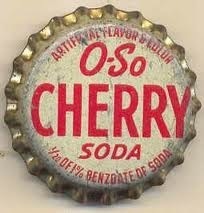 John A. Stavola, Jr. remembers "as a kid, they bottled the soda right there and the dude (perhaps Ed Kar, son of the founder) used to fish right out of the back window of the place." Diana Bors McPeck used to work there when she was young. Her grandparents were friends with the owners she recalls. "I was paid in pop!"
John A. Stavola, Jr. remembers "as a kid, they bottled the soda right there and the dude (perhaps Ed Kar, son of the founder) used to fish right out of the back window of the place." Diana Bors McPeck used to work there when she was young. Her grandparents were friends with the owners she recalls. "I was paid in pop!"One of the old timers working the same shift as me at the Zug Island coke ovens was nicknamed 'Pop'. He would buy several cases of assorted flavors of O-So pop every day in the spring and summer and roll them in from the parking lot on a hand truck (dolly) with a cooler full of ice. Pop sold the stuff for a dollar a bottle, a 400% markup. He also sold salted peanuts in the summer and fresh roasted chestnuts in the winter. On a hot day, everyone was glad to hear him call out "COLD POP." He was a door machine operator on the receiving end of the ramming machine. For the life of me, I can't remember his real name. Everybody just called him Pop.
When I worked as a laborer at Zug Island in 1967, the Delray downtown area already showed signs of two decades of neglect. Many of the shops and second story residences became little more than tenements for transient workers. After the Detroit Riots in July, the writing was on the wall for Delray. Like many other Detroit neighborhoods, white flight went into hyper-drive.
It's always sad to see an established community fall into ruin and abandonment. But almost one hundred years of history and heavy industry had taken its toll on the Delray neighborhood and turned it into what it is today, a virtual ghost town within the Detroit city limits.
Delray lost its ethnic heart and soul in the sixties. What was once a vibrant European mixture of Hungarian, Slovakian, and Polish immigrants dispersed among the Detroit suburbs, notably the Downriver areas of Allen Park, Lincoln Park, and Wyandotte.

Now, all that's left of the Delray neighborhood are mostly memories and photographs fading in family albums. Remember any of these places? First Slovak Church (Holy Redeemer), St. John's Catholic Church, The Hungarian Village Bakery, Hevesi Cafe (with dining and dancing), Joey's Stables, Fox Hardware, Szabo's Meat Market, Delray Baking Company, Al's Bar, Kovac's Bar, and King's Chinese Restaurant. They are gone but not forgotten.
Realistically, Delray is zoned for heavy industry and will never recover as a viable residential area. But I could be wrong. What impact the new international transport bridge will have on Delray is yet to be known or felt. One thing is for certain, the area is ripe for some sort of redevelopment.
For more detailed information on the community of Delray, check out this link: http://en.wikipedia.org/wiki/Delray,_Detroit
Published on August 30, 2014 06:00
August 24, 2014
The Rainy Day Murders Preparing for the Next Hurdle - Representation
 Photo courtesy of Nicole C. Fribourg
Photo courtesy of Nicole C. FribourgI am finally at a point with my true crime project The Rainy Day Murders when it is time to get outside people involved. Getting this book ready for publication has been essentially a two person operation. For over the last three years, Ryan M. Place of Detroit has tirelessly researched the Washtenaw County murders (July 1967 - July 1969) of seven young women and the person accused of killing them, John Norman Collins.
Together, we have gone through thousands of pages of vintage government documents and newspaper clippings from the era, searched various archives in the towns of Ypsilanti and Ann Arbor where these events occurred, and conducted countless interviews with people who have first-hand knowledge of this case and/or the people involved with it.
Assembling these disparate elements has been akin to aligning a Rubic's Cube with some of the colored decals missing. Without the candid cooperation of the offender and the release of all government documents connected with these cases, the full facts will never be known. Still, by repeatedly invoking the Freedom of Information Act, Ryan and I have pieced together enough of the puzzle to reveal a gestalt of evidence and circumstance that goes far beyond the purview of random coincidence and lays the burden of guilt squarely at Collins' feet. Originally, the working title for this project was In the Shadow of the Water Tower. I changed it in favor of The Rainy Day Murders (RDM), so as not to besmirch the city of Ypsilanti's beloved landmark which played no part in any of the murders. The sum total of the information we have compiled has been reduced to 645 pages of hard-wrought manuscript. During my latest rewrite and revision, it became clear to me that I really had two books worth of material, not only because of length considerations, but also because of thematic focus.
 Ryan M. PlaceThe original scope of the project was to fill a void in the historical account of the Washtenaw County murders and restore the identities of the victims that have been obscured by time and a couple of misguided treatments of this subject matter. I have the benefit of over forty-five years of hindsight which those authors didn't have.
Ryan M. PlaceThe original scope of the project was to fill a void in the historical account of the Washtenaw County murders and restore the identities of the victims that have been obscured by time and a couple of misguided treatments of this subject matter. I have the benefit of over forty-five years of hindsight which those authors didn't have.But new material started coming to us from the Michigan Department of Corrections (MDOC) which goes behind prison walls and tells the story of John Norman Collins' years as MDOC inmate #126833. That story looks into his prison record, his escape attempts, Collins' many court appeals, California's extradition efforts, both Canadian treaty transfer attempts, his media manipulations, and a survey of some of John's prison letters which reveal his present life behind bars.
This story is still unfolding, but its climax will be John Norman Collins' fantasy defense in the Karen Sue Beineman murder case. It is quite amazing and lays bare the interior workings of his mind feigning the inability to separate fact from fiction.
My writing instincts tell me that the focus of the first book should be the crimes, the victims, the living history, and the facts as they stand or fall in the Karen Sue Beineman trial. That book comes in at 495 pages without supplemental material.
The second book has its focus on John Norman Collins since his conviction. It doesn't seem appropriate to include material about his life in prison in a book about his crimes against seven innocent, defenseless women whose fatal flaw was not recognizing danger until it was too late. As it currently stands, this second book is still in development. It is 150 pages long and has the working title of The Ypsi Ripper.
Published on August 24, 2014 05:53
August 17, 2014
The Prosecutor's Conundrum in the John Norman Collins' Cases
 The Burden of JusticeOf the seven young Michigan women thought to be the victims of a sadistic serial killer in the Ypsilanti and Ann Arbor areas in the late sixties, only one case was brought to trial, the murder case of Karen Sue Beineman on July 23, 1969.
The Burden of JusticeOf the seven young Michigan women thought to be the victims of a sadistic serial killer in the Ypsilanti and Ann Arbor areas in the late sixties, only one case was brought to trial, the murder case of Karen Sue Beineman on July 23, 1969.Arrested on July 31, 1969 was an Eastern Michigan University junior named John Norman Collins studying to be an elementary school teacher. From the second floor courtroom of the Washtenaw County Building in Ann Arbor, Collins was found guilty of Miss Beineman's premeditated murder in the first degree on August 19, 1970. Nine days later on August 28, 1970, Circuit Court Judge John W. Conlin sentenced Collins to life in prison without possibility of parole. After twenty years of serving his life sentence, Collins could be eligible for a pardon by a sitting Michigan Governor. That is Michigan law.
Washtenaw County Prosecutor William F. Delhey made a deliberate decision not to prosecute John Collins for the other sex-slayings he believed Collins to have committed. The law enforcement community was confident that they had the right guy for the murders. The elusive serial killer was finally off the streets and the string of vicious, motiveless killings had come to an end after a reign of terror spanning three violent summers.
Because prosecuting the Beineman case was the most expensive criminal proceeding in Washtenaw County history to date, many people believed the other cases were not prosecuted solely for economic reasons, leaving the grieving families without answers. Somehow, the institutional belief that the greater good of the community had been served was little comfort to them. They had lost a loved one.
 Taking exception with that point of view is Cris Bronson, a former secretary in the office of Prosecutor William Delhey during the span of the trial. She recently shared her insights with me regarding Delhey's decision not to prosecute Collins for the remaining murders.
Taking exception with that point of view is Cris Bronson, a former secretary in the office of Prosecutor William Delhey during the span of the trial. She recently shared her insights with me regarding Delhey's decision not to prosecute Collins for the remaining murders."This oversight was not due to negligence or incompetence on the part of William Delhey. Nor was it about the amount of money which would be spent prosecuting John Norman Collins (for the other murders). Mr. Delhey had a strategy which was designated to keep Collins in prison for the rest of his life. Further prosecution was designated to occur successively if there was any risk that Collins was to be pardoned or otherwise released. This decision by William Delhey may have given rise to doubt over Collins' guilt in the other cases. But not so!
"Mr. Delhey had prosecuted another murderer of several individuals, throwing the full weight of each murder in one case against the defendant. The offender pleaded guilty by reason of insanity. Some time after this multiple murderer was committed, the State of Michigan changed its laws regarding those offenders who plead insanity defenses and were remanded to mental hospitals for the rest of their lives. The intent of the new law was to prevent mental health facilities from acting as prisons. The result in this specific instance was that this multiple murderer was released onto Michigan streets.
"Mr. Delhey tried to refile criminal charges against this defendant because the time for filing an appeal in the case had long run out. But the circuit court judge who had been assigned the second trial threw the case out as 'double jeopardy.' State and Federal laws prohibit charging an individual twice for the same crime once an official decision had been rendered in the first trial. Prosecutor Delhey was mindful of this and was determined that Collins would stay behind prison bars in Michigan to serve out the full measure of his sentence - life in prison.
"With respect to the law, the public release of evidence collected in the murders of the other victims held in abeyance cannot be made public. But Mr. Delhey had enough evidence to bring charges for each successive case as follow up to prevent this serial killer from being released to harm anyone else again. Although these cases are cold, they still remain officially open. There is no statute of limitations on murder."
 There you have it. The State's evidence in these other cases would be inadmissible in court if the chain of custody were broken or if the facts were released to the public. This evidence will likely never be revealed, even after fifty years or when all the parties to these cases have passed on.
There you have it. The State's evidence in these other cases would be inadmissible in court if the chain of custody were broken or if the facts were released to the public. This evidence will likely never be revealed, even after fifty years or when all the parties to these cases have passed on.
Published on August 17, 2014 13:58



